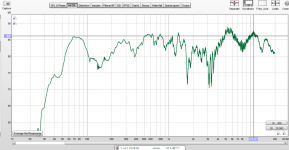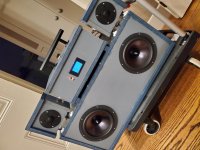Being outside, on a table, gets rid of room modes but does not mean anechoic conditions by any means.
Yikes, I don't have a 30 foot high pole or a large hole. XD What do you mean by gated preamp measurements? Do you mean that the high frequency and low frequency drivers are measured separately?
Last edited by a moderator:
Okay so per all your suggestions here's what I'm thinking. Instead of using a table, I will set up a stand of some sort a few feet above the ground outside to try and minimize reflections. I'll do close up measurements of the woofer and the tweeter first. I believe the drivers are fairly flat but I think the tweeter has a rising response issue and the woofer is a little peaky down low. After I get those two as flat as I can close up, I'll move the mic back a few feet and make sure it's in a position where any adjustment I make on the minidsp (3 db reduction at 70 hertz, 2 db boost at 2.5 khz, etc.) is visible through my measurements and is exactly the db count I'm boosting or reducing by. (I'm assuming that I'll have to move the mic around when I switch from the woofer to the tweeter to keep things accurate like some of you said) How does this sound? Am I on the right track? Any other tips?
To avid long typing, here´s a basic explanation of Gated (for mid/high frequencies) and Nearfield (for lower ones) measurementYikes, I don't have a 30 foot high pole or a large hole. XD What do you mean by gated preamp measurements? Do you mean that the high frequency and low frequency drivers are measured separately?
Loudspeaker measurements
I´m certain some Forum member will point to a detailed step by step procedure, but this is a basic idea.
Notice this also comments on the high-pole and hole-in-the-ground techniques and a couple more 😀
Also, I did some close up measurements of the drivers and a measurement two feet away. These are outdoor measurements btw. Woofer: 20200614_230619.jpg - Google Drive
Tweeter: 20200614_230609.jpg - Google Drive
Measurements from two feet away: 20200614_230558.jpg - Google Drive
Can anyone give me input on these measurements? Also, how do I match the woofer and tweeter to make sure one is not overpowering the other?
Tweeter: 20200614_230609.jpg - Google Drive
Measurements from two feet away: 20200614_230558.jpg - Google Drive
Can anyone give me input on these measurements? Also, how do I match the woofer and tweeter to make sure one is not overpowering the other?
Last edited:
So going from a close measurement to a 2 feet away measurement changes the response drastically. Can we have a picture of the boxes ?
Rob.
Rob.
Yup: 20200329_193138.jpg - Google Drive
So the spikes on the graph from a couple feet away, are those reflections?
So the spikes on the graph from a couple feet away, are those reflections?
The tweeters are not being helped by having the baffle recessed compared to the edge. Maybe try some felt on the baffle to stop the hard step.
The woofer measurement doesn't look too bad. There's a bit too much distance between the woofer and tweeter. (The mid measurement looks different to the one in post #3 though ?)
If that was my project I'd use a 2" full range driver instead of the tweeter and cross around 300/500 Hz.
Cheers,
Rob.
The woofer measurement doesn't look too bad. There's a bit too much distance between the woofer and tweeter. (The mid measurement looks different to the one in post #3 though ?)
If that was my project I'd use a 2" full range driver instead of the tweeter and cross around 300/500 Hz.
Cheers,
Rob.
Basically, two things change about the ratio between the direct sound and the reflected sound, as you move back. Firstly, the relative level of the reflections becomes closer, so they appear more obviously on a plot.
Secondly, they also get closer in time. You ought to be looking at your impulses and identifying them and gating, if possible, or else moving the speaker.
Secondly, they also get closer in time. You ought to be looking at your impulses and identifying them and gating, if possible, or else moving the speaker.
The tweeters are not being helped by having the baffle recessed compared to the edge. Maybe try some felt on the baffle to stop the hard step.
The woofer measurement doesn't look too bad. There's a bit too much distance between the woofer and tweeter. (The mid measurement looks different to the one in post #3 though ?)
If that was my project I'd use a 2" full range driver instead of the tweeter and cross around 300/500 Hz.
Cheers,
Rob.
The measurements in post # 3 were done on a table, which is why I'm guessing the mids look different. Will felt smoothen out the frequency response for the tweeters? The sound is very bright right now, and it sounds like the sound systems they use at concerts or parties 🙁 Just wondering why you would use a fullrange over a tweeter?
Allen, how do I go about identifying the impulses? I already have the speaker outdoors and 4-5 feet away from any walls and on a stand so I'm not sure what else can be causing the reflections.
It keeps the distance between drivers within 1/4 wavelength at the (lower )crossover point.
Rob.
Rob.
The impulse will tend to repeat at lower levels at later times, and typically you would box in the main one.
However the cabinet edges may also be the source of reflections. Maybe you could take another 2' shot and then repeat it, without moving the mic but after blocking the gap around the tweeter baffle.
However the cabinet edges may also be the source of reflections. Maybe you could take another 2' shot and then repeat it, without moving the mic but after blocking the gap around the tweeter baffle.
That is NO separation!!!have the speaker outdoors and 4-5 feet away from any walls and on a stand so I'm not sure what else can be causing the reflections.
Tons of strong reflections at such meager distances!
Talk about 10/15 METERS away and we are starting to talk.
Same with pole height.
Or, Plan B: learn about gating the impulse so the *inevitable* reflection arrives outside the measuring window and at low frequencies, use close measurement and pray.
Plan C: stop worrying, no matter what/how you measure you will later use those speakers on a normal room.
Or normal outdoors (Colorado Grand Canyon or Sahara desert do not count as "normal") so accept the "real World" curves.
Alright, I will learn about gating the impulse and adding some sort of dampening material around the tweeter baffle. I'll also move the speaker much further away from any surfaces. 🙂
The impulse will tend to repeat at lower levels at later times, and typically you would box in the main one.
However the cabinet edges may also be the source of reflections. Maybe you could take another 2' shot and then repeat it, without moving the mic but after blocking the gap around the tweeter baffle.
By blocking the gap around the tweeter baffle, do you mean putting something in between the woofer and tweeter enclosure, so all the currently separate enclosures are touching each other? There's a 1/4 inch gap between the tweeter and the woofer enclosure.

Here's another measurement without dsp where the speaker was atleast 10 feet away from any walls, and with foam added to the baffle. This isn't smoothed. Is the response smooth and reflection free enough to be used for dsp without gating the measurements? Or should I still do that? Btw, really thanks for the foam suggestion, it does sound noticeably smoother.
Perhaps you should be gating these, there is too much information there that doesn't represent what the speaker fundamentally does. You will be chasing shadows.
If you take a look at a manufacturers plot you will see what it normally will look like, if you make allowances for the different baffling that you use.
If you take a look at a manufacturers plot you will see what it normally will look like, if you make allowances for the different baffling that you use.
As a side note, whether you choose to cross based on a single measurement or a full representation of the sound field is one thing. Whether this particular measurement is fit for purpose is another thing.enough to be used for dsp
- Home
- Loudspeakers
- Multi-Way
- Struggling with EQ on a portable speaker
